Making your own authentic Thai green curry paste (พริกแกงเขียว) will heighten the flavors of your curries to a whole new level! The fresh herbs and fragrant spices heighten authentic Thai curries' bold and delicious flavor!
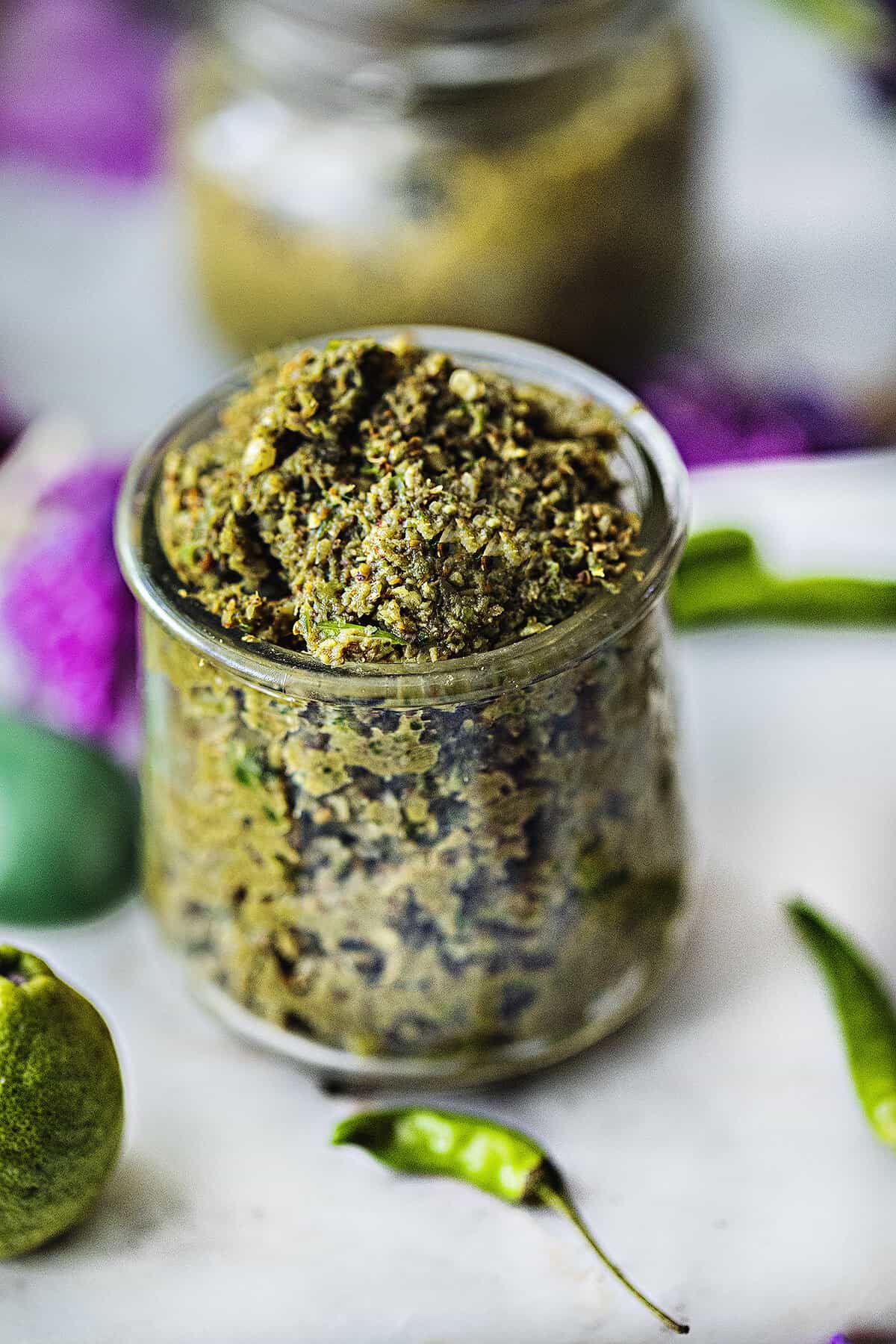
After making your own Thai green curry paste from scratch, make my authentic Thai curry recipes. Try my delicious easy Thai green curry recipe and this bold, flavorful Thai green chicken curry fried rice. Both are tasty!
Jump to:
- Why make your homemade curry paste?
- What is Thai Green Curry Paste Made of?
- More homemade Thai curry pastes to try
- Ingredients for Making Authentic Thai Green Curry Paste
- How To Make Authentic Thai Green Curry Paste
- Helpful kitchen notes and expert tips
- More homemade Thai curry pastes
- VARIATIONS
- STORAGE
- SUBSTITUTION
- FAQs
- More Thai recipes you'll love
- Related Recipes
- Authentic Thai Green Curry Paste, พริกแกงเขียว
Why make your homemade curry paste?
- Making homemade green curry paste will give you the ultimate traditional and homemade Thai flavors that will change how you taste curries.
- Making your paste from scratch will give you the most authentic Thai green curry paste experience. It's healthier and tastier, hands down.
- Green curry paste lasts a few days in the refrigerator (10-14 days!) This allows you to make the paste ahead of time if you don’t have the time to make the paste and your curry recipe in one sitting.
- Green curry paste freezes well and will keep in an airtight container for up to 4 months.
- Once you know how to make your paste, you can use it in many Thai dishes! Check the recipes below for more green curry recipes.
What is Thai Green Curry Paste Made of?
Thai green curry is made of fresh green chilis, aromatic herbs like lemongrass, galangal, cilantro roots or stems, shallot, garlic, and kaffir lime zest. It also uses fragrant toasted spices like whole white peppercorn, cumin, and coriander seeds.
And, of course, the pungent shrimp paste gives the curry paste its traditional flavor. Don't skip it! (:
More homemade Thai curry pastes to try
- The best authentic massaman curry paste
- Authentic Thai yellow curry paste
- Authentic green curry paste
- Authentic red curry paste
- Authentic Prik Khing curry paste
- Authentic Choo Chee curry paste
- Tom Yum curry paste
Ingredients for Making Authentic Thai Green Curry Paste
Below are key ingredients to make authentic Thai green curry paste. Most of these simple ingredients can be found at your local Asian markets.
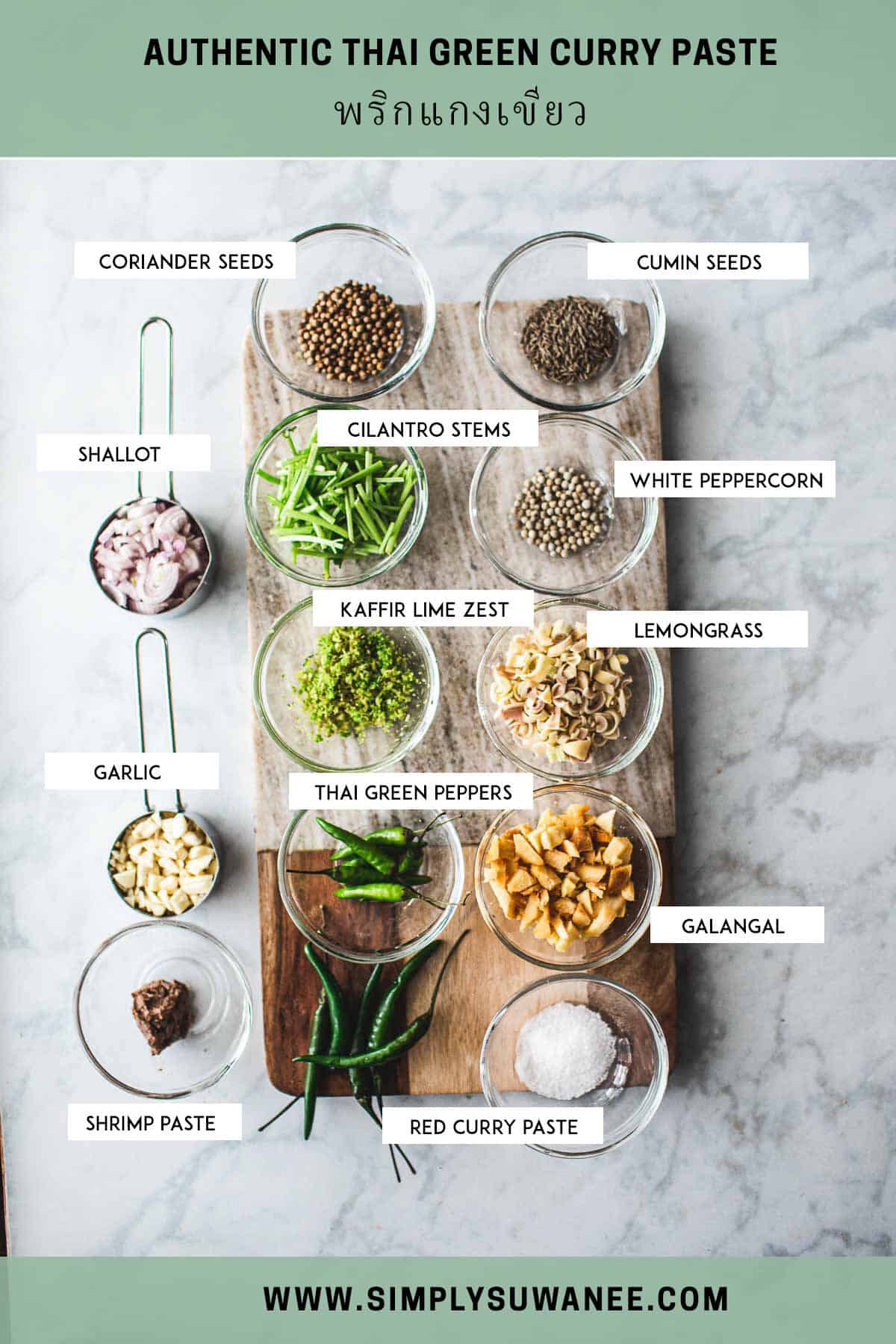
Dry Spices
Using whole spices will yield the best results when making your green curry paste. They are always more fresh and flavorful than the powder forms. Most of these spices can be found at your local Asian grocery store.
- White peppercorn. White peppercorns are made from ripe black peppercorn berries. The skin is soaked and stripped, making the white peppercorns less spicy. Use ground white pepper if you can't get whole peppercorns.
- Coriander seeds. Coriander seeds are easily found in the spice section of most Asian markets or your favorite spice shops. The coriander powder is more common and can be found in your local grocers.
- Cumin seeds. Cumin seeds are easily found amongst the other dry spices mentioned above. Cumin seeds are considered fresher and more fragrant. Use seeds if possible, but the powder will work fine too.
- Salt. I recommend using kosher or Himalayan fine-grain salt. Salt is essential to make the curry paste in a mortar and pestle. It helps break down the oil of the peppers and makes it easier to crush them into a fine paste.
Wet/Fresh Herbs
The remaining fresh ingredients are the softer herbs needed for this recipe. Use fresh, not dried-up herbs for the best fresh curry paste. Find these delicious ingredients in the Asian grocery stores s near you.
- Fresh green chilies. This is the main ingredient for making Thai green curry paste. Use fresh Thai green chiles. The smaller bird's eye peppers are extremely spicy. Use them sparingly if you are sensitive to heat. You can also use the longer Thai chilis; they are about 3-4 inches long. Use jalapenos for a less spicy version. Mix and match the chilis to find a perfect fit for your spiciness level. Always remove the seeds with a small knife and use kitchen gloves to spare your skin from burning. Trust me on this one. (;
* Add a few pieces of green bell pepper for the extra bright green color without adding heat. The Thai green chilies are too spicy to use as an added color.
- Lemongrass. Use fresh lemongrass if possible, and only use the rounded 3-5 inches part of the stem. Make sure to chop your lemongrass into fine pieces before pounding to help speed up the paste-making. Use frozen lemongrass if fresh ones are not available to you. Read more about Lemongrass and how to use it in Thai cuisine.
- Galangal. Use fresh or frozen galangal only for Thai curry paste recipes. Never use dried or powdered galangal. Also, never substitute ginger for galangal; they are two completely different ingredients with different flavors and fragrances. Most Asian markets will have fresh or frozen galangal. Read more about Galangal in Thai cooking here.
- Kaffir lime zest. (The fresh kaffir lime peel) This is the one ingredient you may not be able to find fresh, even at some well-stocked Asian stores. If you cannot find fresh kaffir limes, try the following as a substitute. Use one teaspoon of lime zest plus 3-4 Kaffir lime leaves. If you can find key limes, use 3-4 key limes instead of 1 medium-sized lime. Key limes have a fragrant profile that is very nice to use as a substitute for kaffir limes. Read more about Kaffir limes and leaves and substitute here.
- Cilantro roots or stems. Also called coriander roots are commonly sold in Thailand as a bunch with roots, stems, and leaves. They are rare in the US, but the stems are the next best option. Use the largest and lowest part of the stems and cut them into small pieces for pounding.
- Shrimp paste. I highly recommend Thai shrimp paste for a more authentic taste in your red curry paste. The smell is potent, but the paste will add a very deep umami taste to your curry paste.
- Shallot. I don’t recommend substituting red onions for making curry pastes. The flavors of shallots are stronger and better.
- Garlic. Garlic is essential in making curry pastes. Since a lot of it is used in each batch, here is a trick to help you peel them more easily. Smash the garlic cloves with the flat side of a knife or a heavy kitchen tool like a pestle. It’s easier to peel off the garlic skin once smashed.
Ingredient notes: some recipes call for Thai basil leaves or Thai sweet basil to add to the paste to make Thai green curry paste. I don't recommend it as the basil has a strong flavor profile that doesn't fit in with the pastes. Save the basil leaves for adding to your green curries instead.
How To Make Authentic Thai Green Curry Paste
I'll show you two methods for making my green curry paste recipe. The first, a more traditional and arguably more flavorful method, is to pound all ingredients in a heavy mortar and pestle.
The second method is easier and fast, using a food processor or blender to mix all the ingredients. Both methods will give you great results, so I hope you try both and decide what you like better! Let's get started.
Method 1. In a food processor
Step 1. Toast the white peppercorn, coriander, and cumin seeds on medium heat until fragrant, 2-3 minutes. Remove from the skillet to a small plate and let cool.
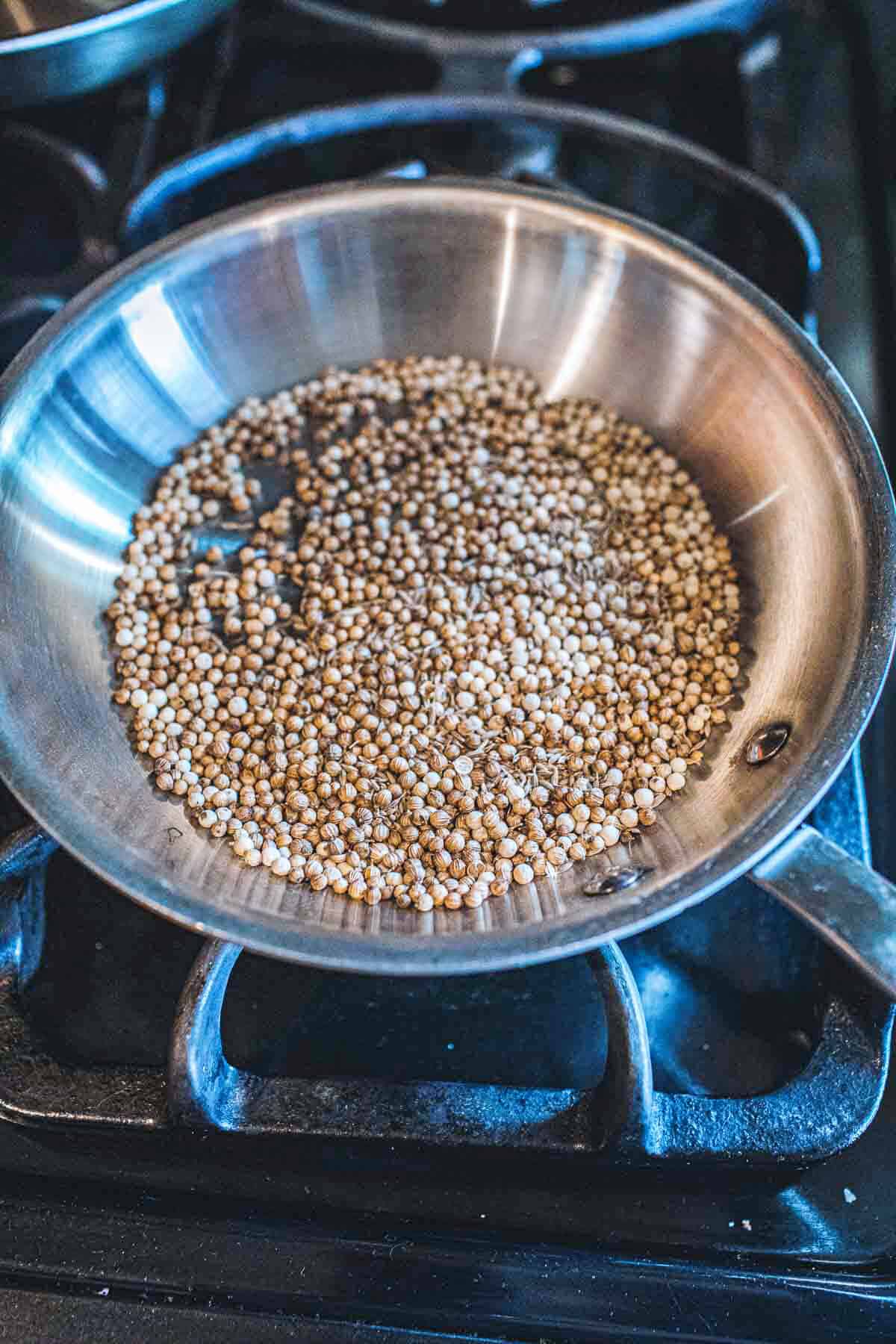
Step 2. Use a spice grinder or a small mortar and pestle to ground the toasted seeds to powder. Place the freshly ground powder into a food processor with the other ingredients.
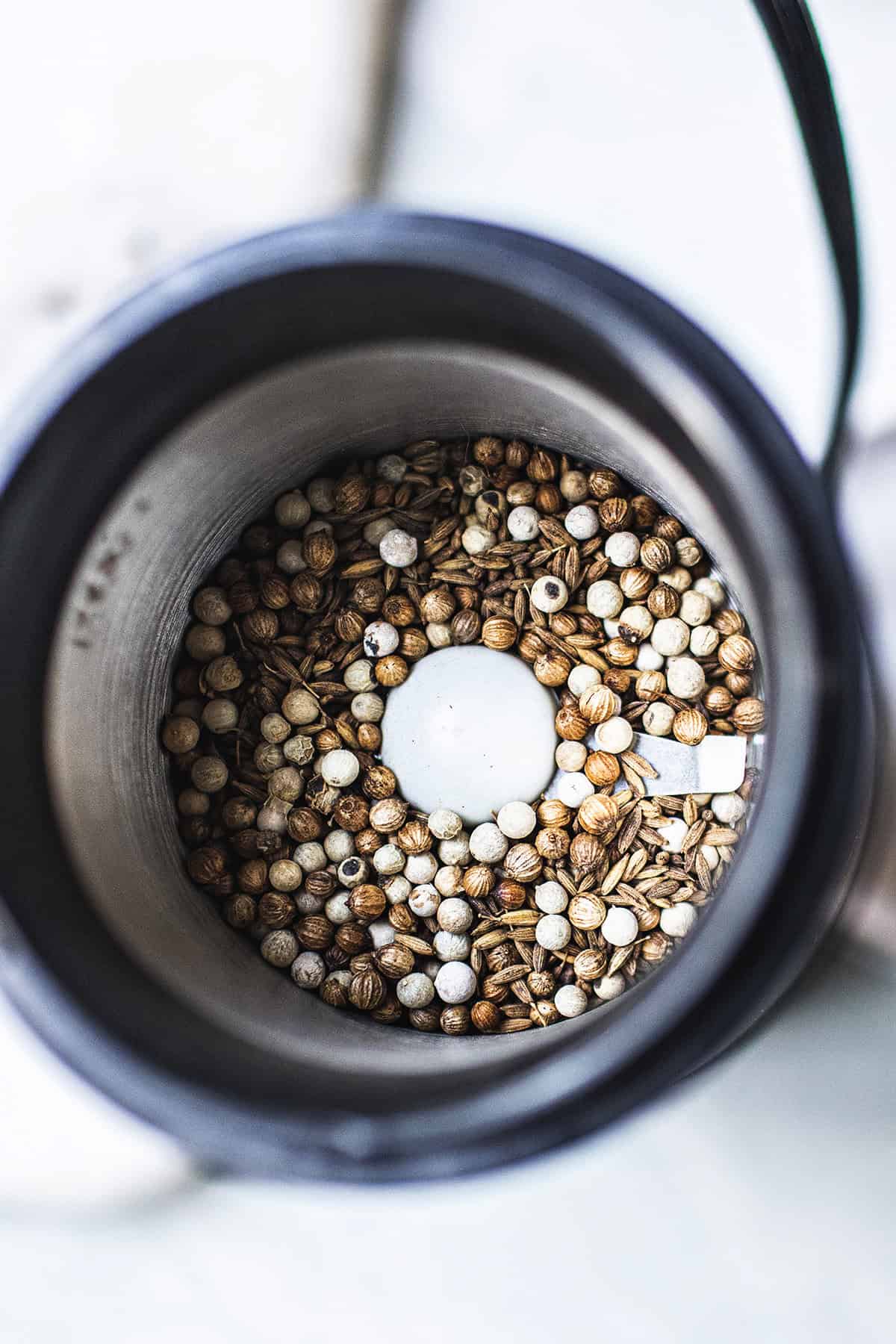
Step 3. Add all the ingredients into a small food processor and blend until your paste is smooth. Add a very tiny amount of water if your paste is too dry. You shouldn't need to but don't use more than one tablespoon for the recipe.
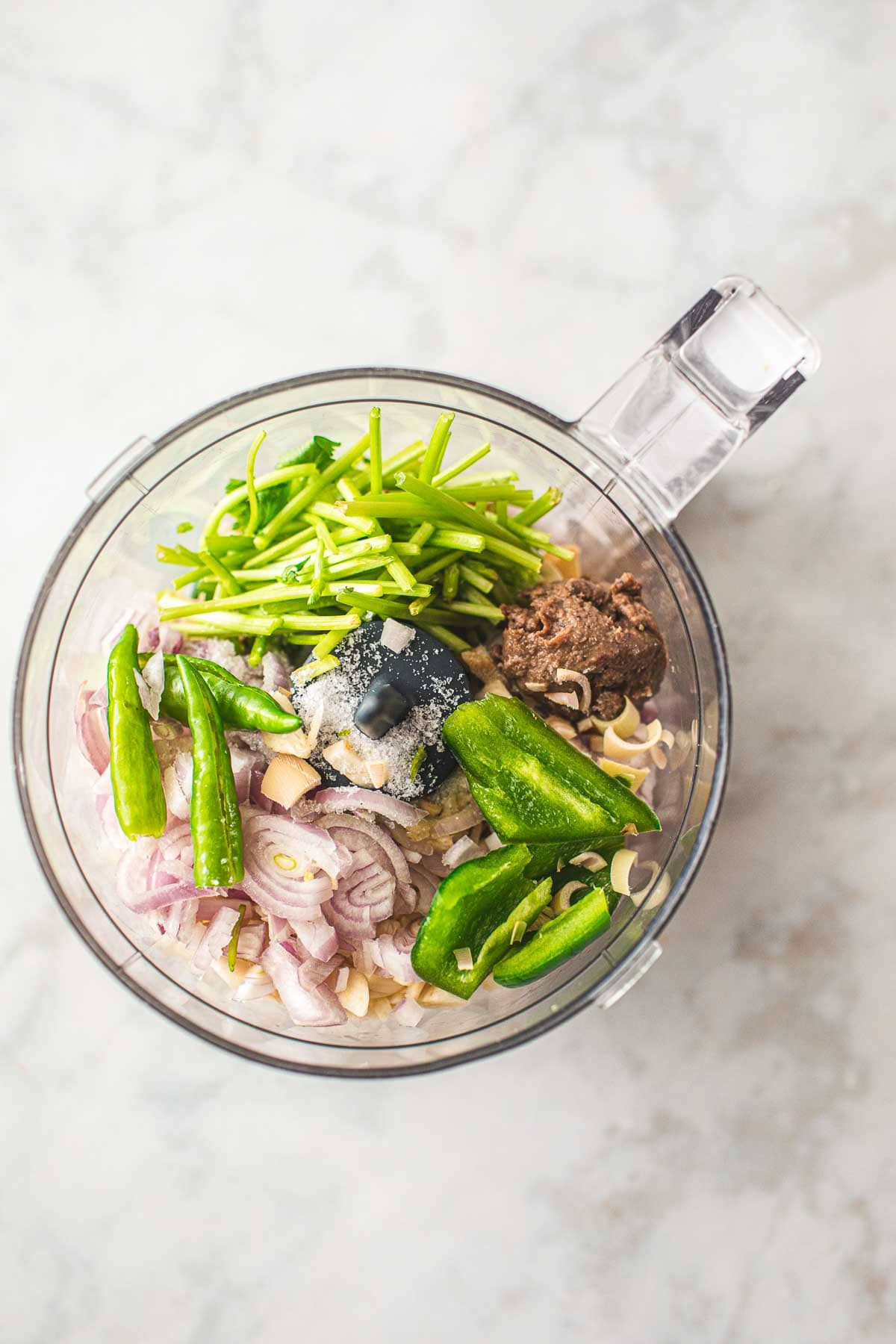
Step 4. Remove the paste for use. Done! Store leftover paste in a glass jar, in the fridge for up to 10 days, and in the freezer for 3-4 months.
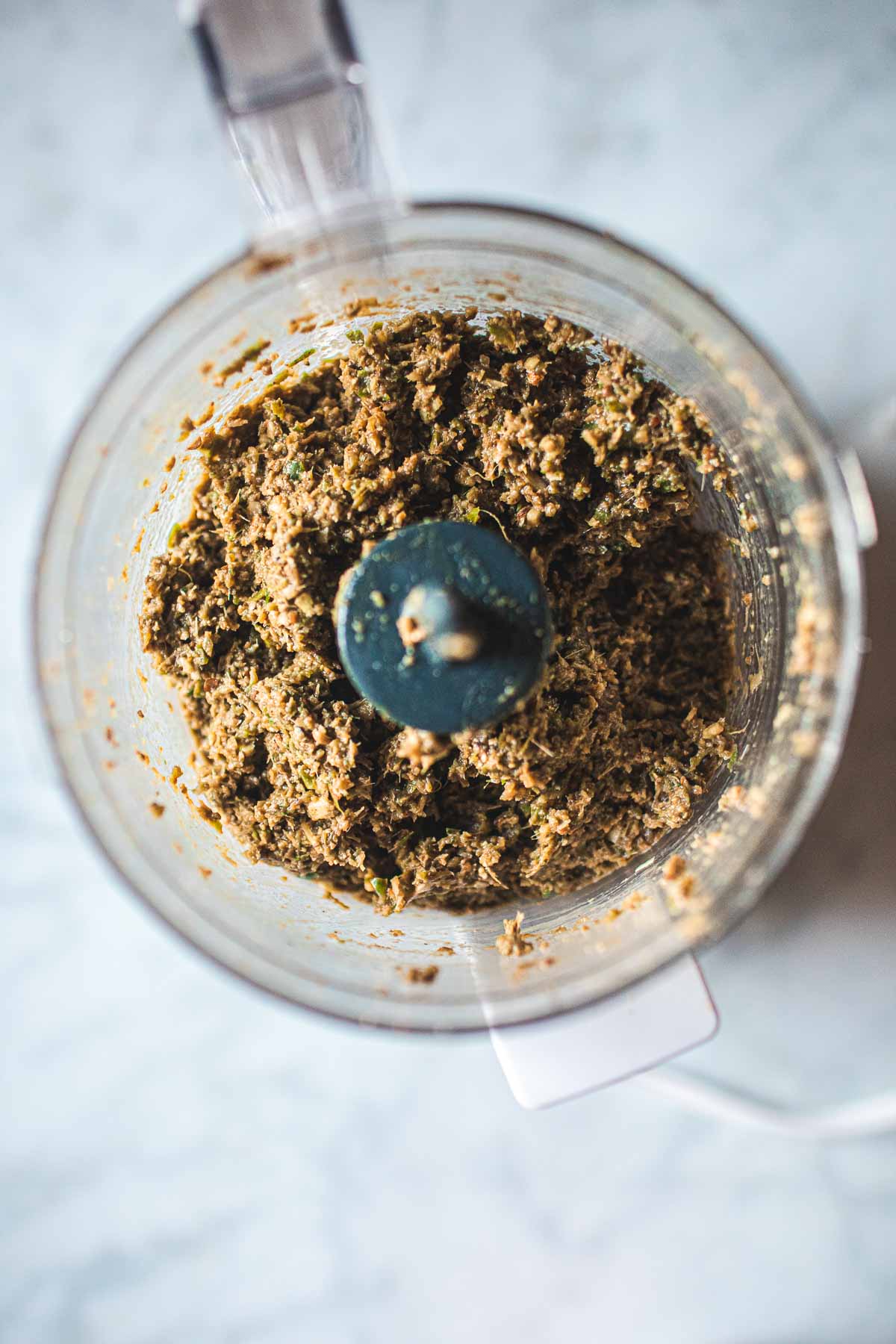
Method 2. In a mortar and pestle
Step 1. On a small skillet, toast white peppercorn, coriander, and cumin seeds on medium heat until fragrant and you hear some seeds popping from the pan. It takes about 2-3 minutes. Once cooled, use a spice grinder to turn it into powder. Set aside for pounding in a minute.
Step 2. Add galangal and lemongrass to a sturdy mortar and pestle and pound until you have a smooth paste.
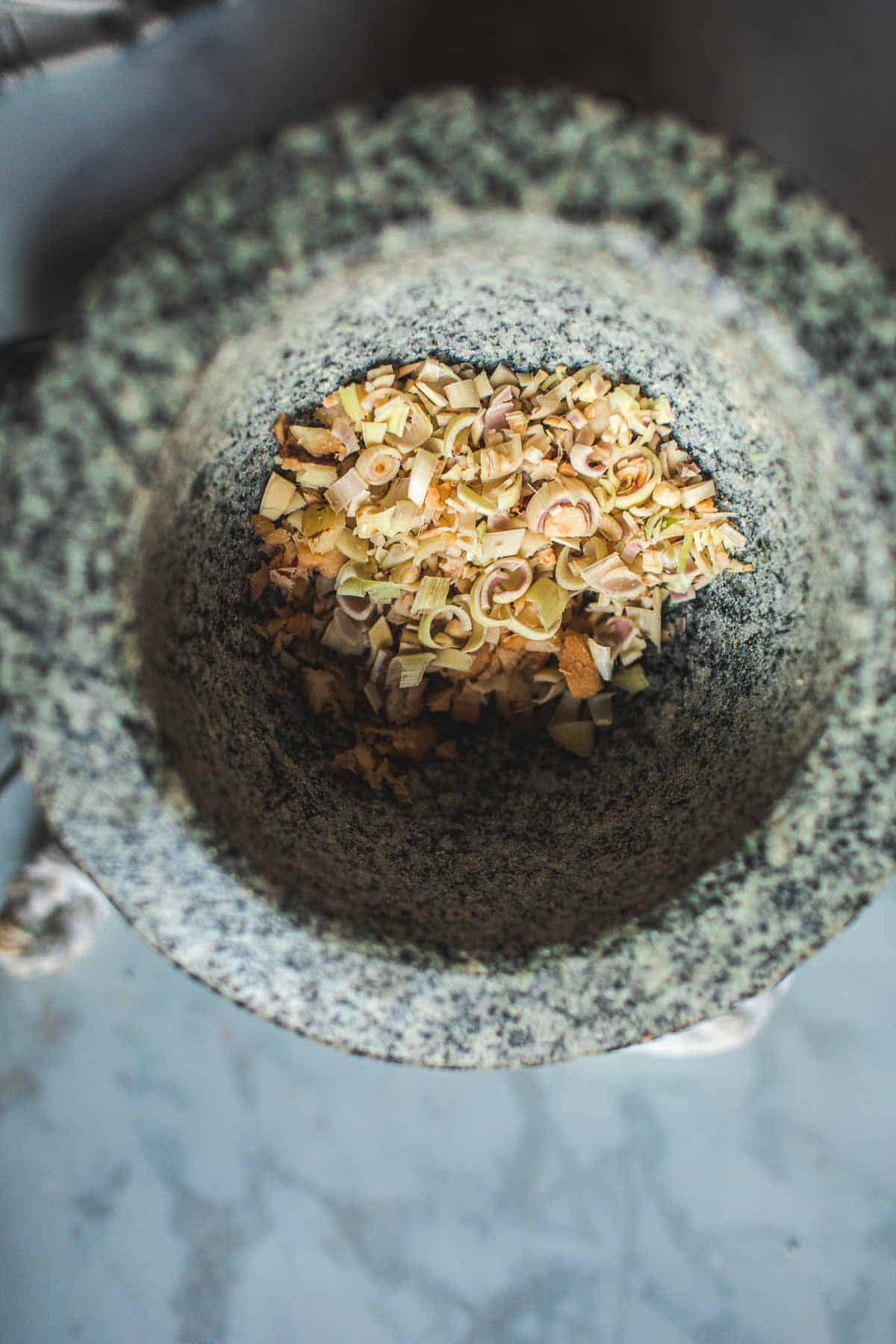
Step 3. Add all the greens- green chilis, cilantro stems, and kaffir lime zest. Pound until bright green paste forms.
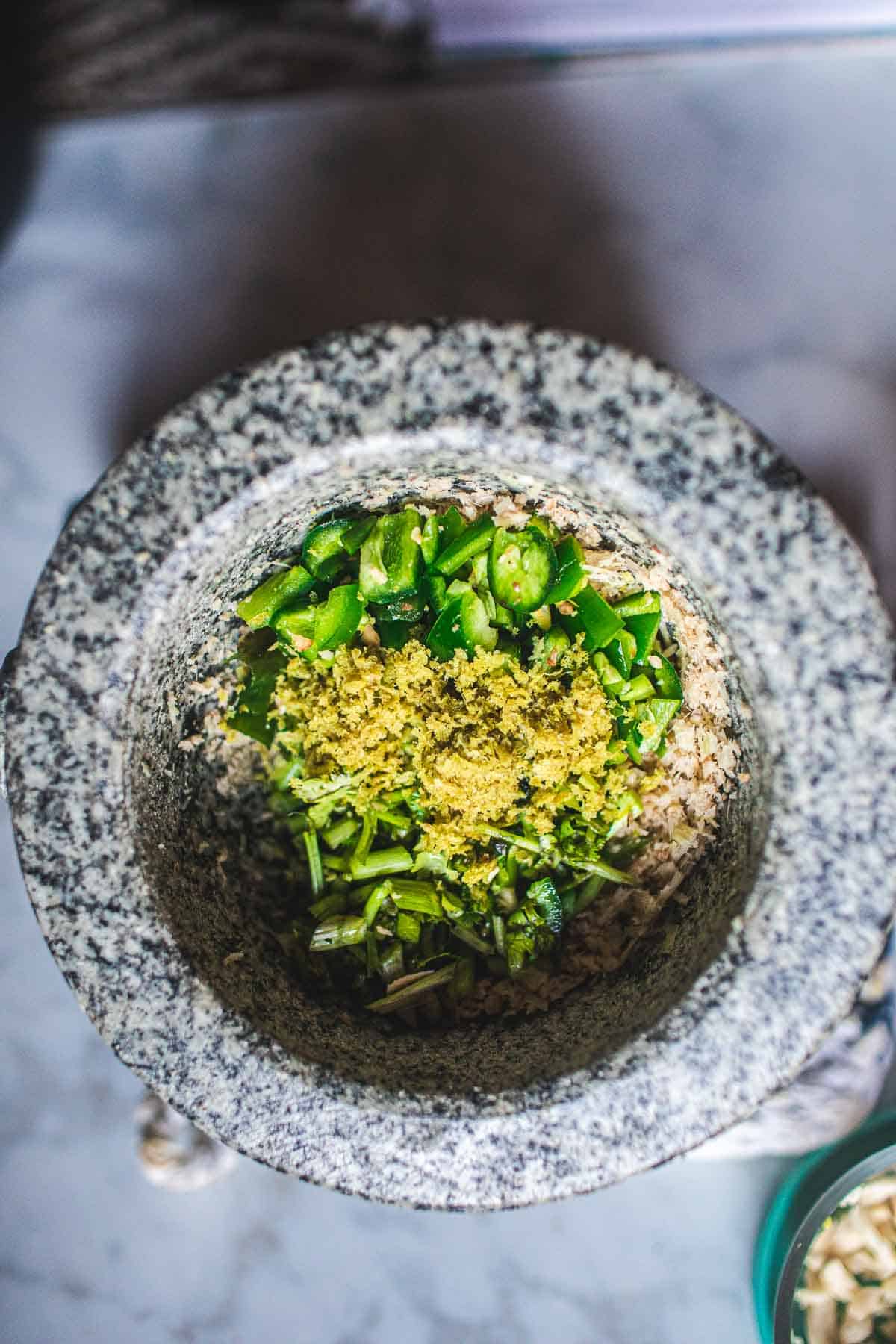
Step 4. Add garlic, shallot, and salt, and keep pounding away again.
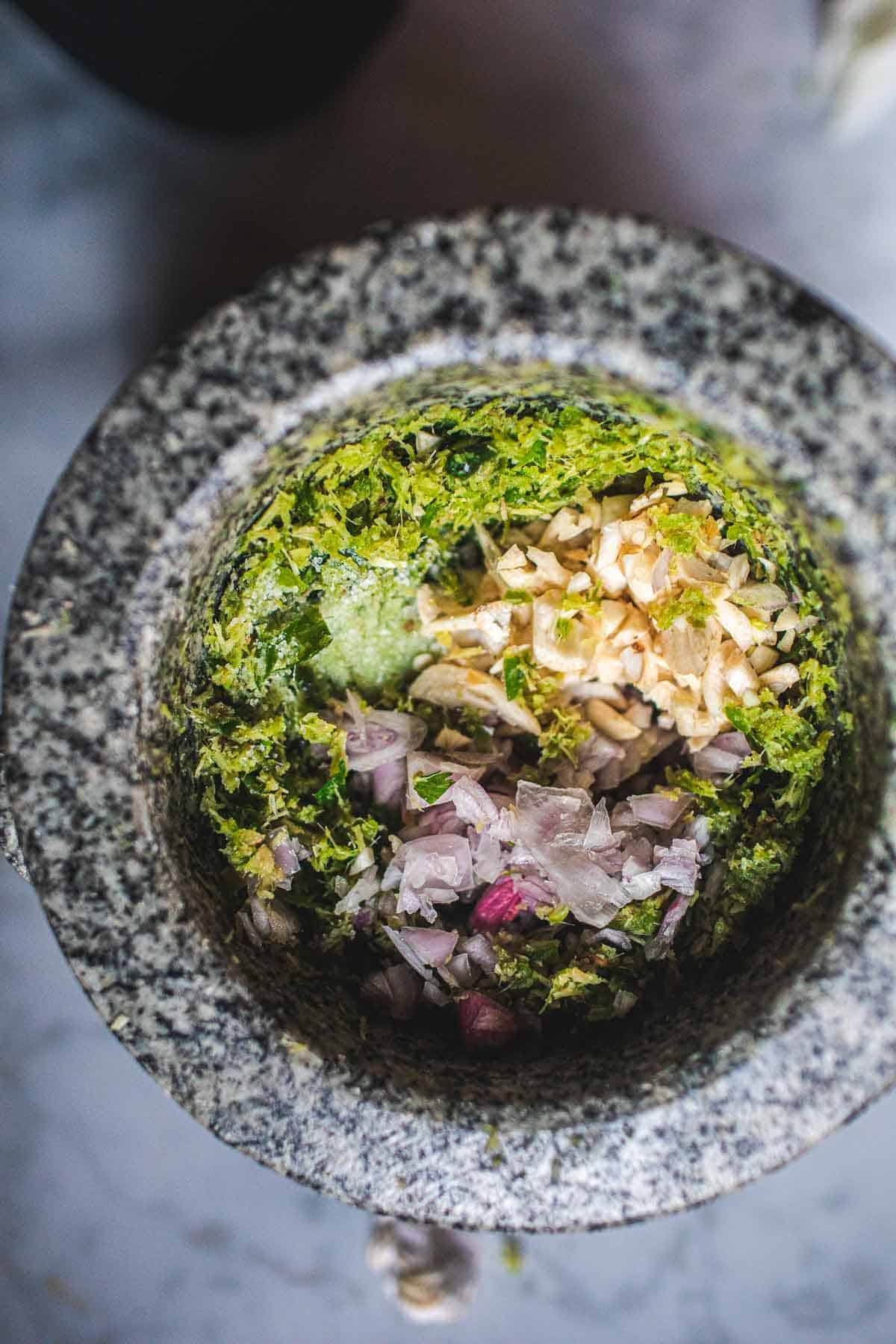
Step 5. Add the ground spices, and you should have a smooth brownish-green paste. (The spices turned the green paste brown, it’s normal!)
Step 6. Add shrimp paste last and mesh it all up with the paste until everything is completely well blended and no large chunks appear. That's it! You just made your curry paste, and it’s ready for use!
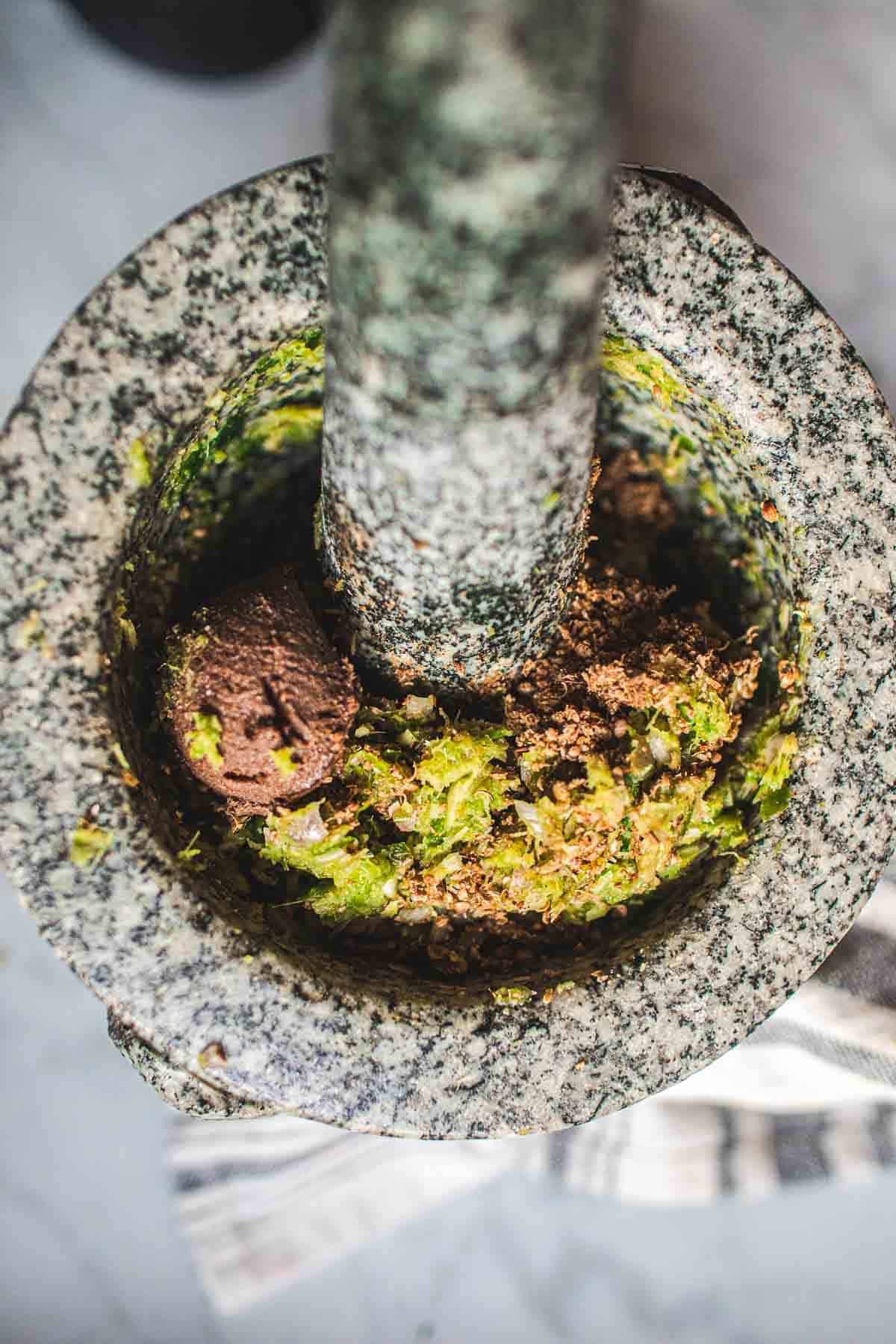
Helpful kitchen notes and expert tips
- When handling chilis and removing the seeds, kitchen gloves are a must, or you can hurt yourself with the hot oils of the chilis burning your skin. It’s a very unpleasant experience.
- Don’t let the seeds get too burnt, or your paste will have an unpleasant bitter taste. Use a wooden spatula to stir the seeds into the pan.
- Use a solid, strong mortar and pestle to pound away the ingredients. It’s an arm workout to make curry paste the traditional way. Be sure not to use clay, marble, wooden, or decorative mortar and pestle for pounding the curry paste. They are not strong enough and could break.
- Best not to pound more than three ingredients at a time as it gets tiresome to pound in large quantities. Also, you may have big chunks of uncrushed ingredients if adding too many items.
- Always pound the toughest and most fibrous ingredients first, as listed in the steps above and the recipe card.
- Add the shrimp paste last. It’s the softest ingredient for the paste, and if added too soon, I find it more difficult to pound the ingredients into a paste because it's too wet and slippery.
- Shrimp paste is a must for the traditional umami flavors that ties all the strong spices and herbs together. Don’t skip out if you can help it!
- Using a smaller stone mortar and pestle, you can break up your paste into smaller 2-3 batches to ease pounding the ingredients together. Add them all together in a bowl for the final finished paste.
More homemade Thai curry pastes
Try these different types of Thai curry pastes at home. These are healthy recipes full of healing herbs and spices that Thai food is known for! Give them a try.
- Authentic Thai yellow curry paste
- Authentic green curry paste
- Choo Chee curry paste
- Red Thai curry paste
- Tom Yum paste
VARIATIONS
You can make this homemade Thai green curry paste recipe into a vegan or vegetarian version. The best substitute I've found is to use Vegemite, a brown paste made from yeast.
STORAGE
The best way to store your homemade green curry paste is in an airtight container in the fridge for up to 2 weeks and up to 4-6 months in the freezer. For smaller quantities, separate the paste and freeze it in ice cube trays for a smaller and easier measurement.
SUBSTITUTION
If you absolutely don't have time to make your paste, my favorite store-bought curry paste is the Mae Ploy brand. The store-bought paste quality, fragrance, and flavors do not match the homemade paste, but Mae Ploy paste has the best flavors for making Thai curries.
FAQs
Thai green curry paste uses fresh green chilis, thus the name and color of the paste. When other herbs and spices that are not green are added to the mix, the green color gets diluted and turns brownish. You can add jalapeños or green bell peppers to make them more green without changing the flavors of the curry paste. Never add basil. Leave to the paste, only to the curry once made.
There are many Thai curry pastes in Thai cuisine. The green curry paste is one of the more popular curry pastes.
There are a couple of methods to make green curry paste. One is using a food processor to blend all the ingredients. Method two is to use a mortar and pestle to pound ingredients together until you have a smooth curry paste.
Thai green curry can make stir-fries, soups, sauces, and more! Check out my delicious Thai green curry recipe here.
No. Curry powder is made from different ingredients for different recipes than green curry paste. Best to try to find store-bought green paste than using curry powder. There is no good Thai green curry paste substitute because the recipe is unique, and if you substitute, it won't be a Thai green curry paste anymore.
More Thai recipes you'll love
- Easy Thai green curry recipe with Thai eggplant
- Thai green curry fried rice
- Thai red curry paste
- Prik Khing curry paste
- Easy red curry green beans with shrimp, Pad Prik Khing curry
- Thai red curry with chicken and pineapple
- Authentic Thai red curry recipe
- Red Thai curry with chicken and kabocha squash
- The different types of Thai rice noodles
** Love a recipe you've tried? Please leave a 5-star ?rating in the recipe card below and/or a review in the comments section further down the page. Or follow me on Facebook, Pinterest, or Instagram! **
Related Recipes
- Easy Thai green curry recipe
- Thai green curry fried rice
- Thai red curry paste
- Prik Khing curry paste
- Easy red curry green beans with shrimp, Pad Prik Khing curry
- Thai red curry with chicken and pineapple
- Authentic Thai red curry recipe
- Red Thai curry with chicken and kabocha squash
** Love a recipe you've tried? Please leave a 5-star ?rating in the recipe card below and/or a review in the comments section further down the page. Or follow me on Facebook, Pinterest, or Instagram! **
Print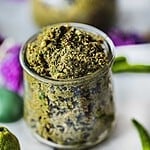
Authentic Thai Green Curry Paste, พริกแกงเขียว
- Total Time: 30
- Yield: 1.5 cups 1x
- Diet: Low Fat
Description
Making your own authentic Thai green curry paste will heighten the flavors of your curries to a whole new level! The fresh herbs and fragrant spices heighten the flavor's bold and delicious taste you find in authentic Thai curries!
Ingredients
- 6 Thai long fresh green chilis, seeds removed and chopped small
- 2 medium jalapenos peppers, seeds removed and chopped small
- ¼ cup lemongrass, chopped small
- ¼ cup galangal, chopped small
- ¼ cup shallot, chopped small
- 2 tablespoons garlic, chopped small
- ¼ cup cilantro stems or roots
- 1 tablespoon kaffir lime zest
- 2 tablespoons coriander seeds
- 1 tablespoon whole white peppercorn
- ½ tablespoon cumin seeds
- 1 teaspoon salt
- 1 tablespoon shrimp paste
Instructions
Method 1. In a food processor
- Toast the white peppercorn, coriander, and cumin seeds on medium heat until fragrant, 2-3 minutes. Remove from the skillet to a small plate and let cool.
- Use a spice grinder or a small mortar and pestle to ground the toasted seeds to powder. Place the freshly ground powder into a food processor with the other ingredients.
- Add all the ingredients into a small food processor and blend until your paste is smooth. Add a very tiny amount of water if your paste is too dry. You shouldn't need to but don't use more than one tablespoon for the recipe.
- Remove the paste for use. Done! Store leftover paste in a glass jar, in the fridge for up to 10 days, and in the freezer for 3-4 months.
Method 2. In a mortar and pestle
-
- On a small skillet, toast white peppercorn, coriander, and cumin seeds on medium heat until fragrant and you hear some seeds popping from the pan. It takes about 2-3 minutes. Once cooled, use a spice grinder to turn it into powder. Set aside for pounding in a minute.
- Add galangal and lemongrass to a sturdy mortar and pestle and pound until you have a smooth paste.
- Add all the greens- green chilis, cilantro stems, and kaffir lime zest. Pound until bright green paste forms.
- Add garlic, shallot, and salt, and keep pounding away again.
- Add the ground spices, and you should have a smooth brownish-green paste. (The spices turned the green paste brown, it’s normal!)
- Add shrimp paste last and mesh it all up with the paste until everything is completely well blended and no large chunks appear. That's it! You just made your curry paste, and it’s ready for use!
Notes
- When handling chilis and removing the seeds, kitchen gloves are a must, or you can hurt yourself with the hot oils of the chilis burning your skin. It’s a very unpleasant experience.
- Don’t let the seeds get too burnt, or your paste will have an unpleasant bitter taste. Use a wooden spatula to stir the seeds into the pan.
- Use a solid, strong mortar and pestle to pound away the ingredients. It’s an arm workout to make curry paste the traditional way. Make sure you don’t use clay, marble, wooden, or decorative mortar and pestle for this job.
- Best not to pound more than three ingredients at a time as it gets tiresome to pound in large quantities. Also, you may have big chunks of uncrushed ingredients if adding too many items.
- Always pound the toughest and most fibrous ingredients first, as listed in the steps above and the recipe card.
- Add the shrimp paste last. It’s the softest ingredient for the paste, and if added too soon, I find it more difficult to pound the ingredients into a paste because it's too wet and slippery.
- Shrimp paste is a must for the traditional umami flavors that ties all the strong spices and herbs together. Don’t skip out if you can help it!
- Using a smaller stone mortar and pestle, you can break up your paste into smaller 2-3 batches to ease pounding the ingredients together. Add them all together in a bowl for the final finished paste.
** Thank you so much for visiting my blog! This is truly a passion for me. If you have enjoyed these recipes and appreciate the hard work I put into them, I would love it if you would share them with your friends! Your recommendation is the highest review I could hope for, and I’d appreciate it! **
- Prep Time: 15
- Cook Time: 15
- Category: Curry
- Method: Food processor
- Cuisine: Thai
Keywords: Authentic Thai Green Curry Paste, พริกแกงเขียว, green curry paste, authentic thai green curry paste, homemade green curry paste

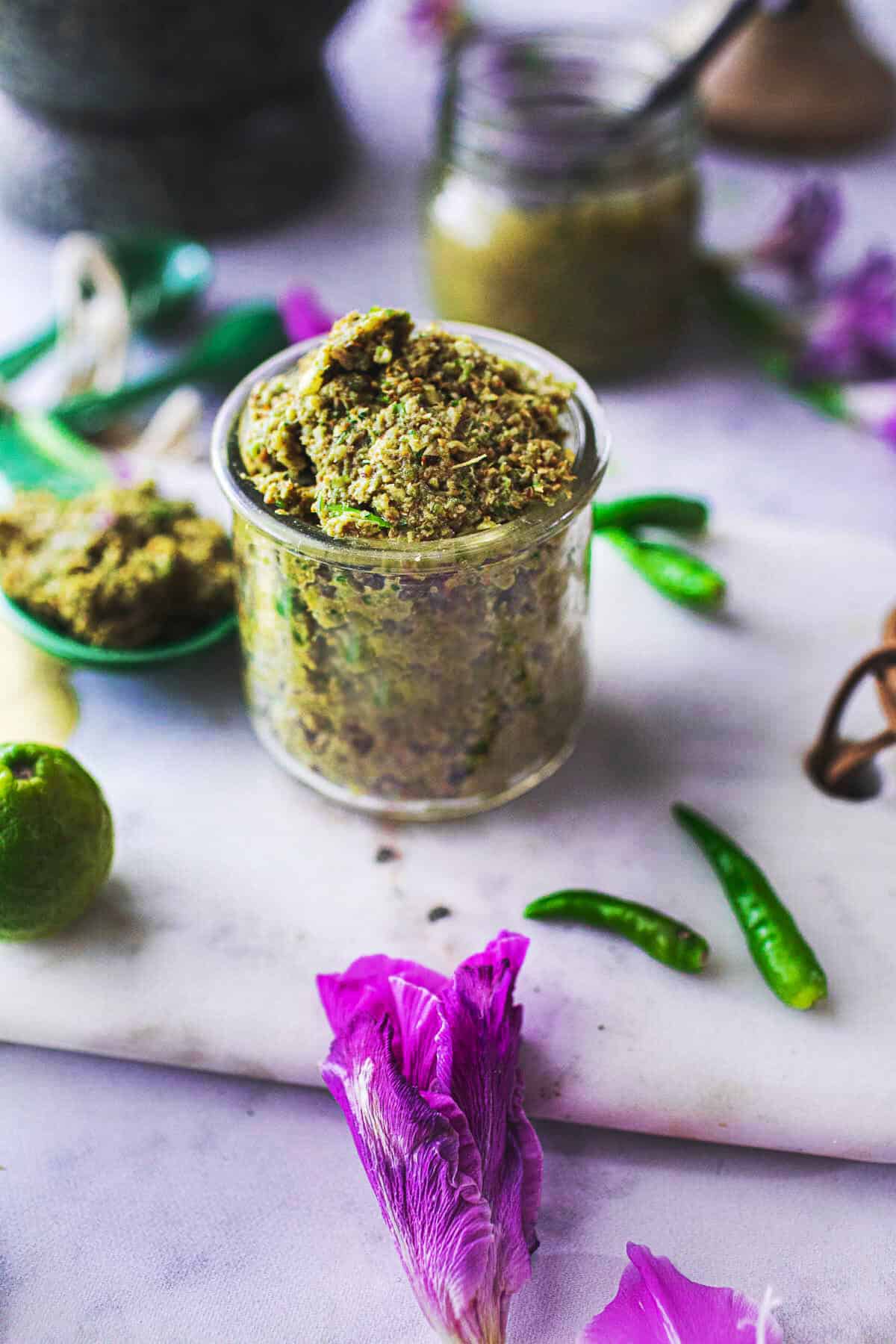
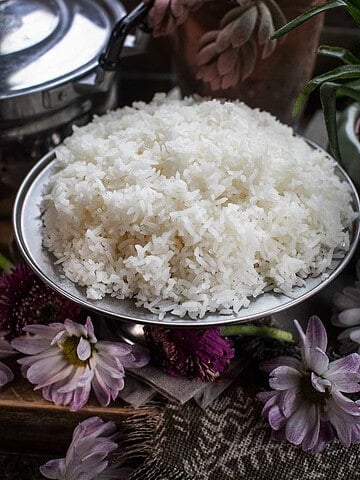
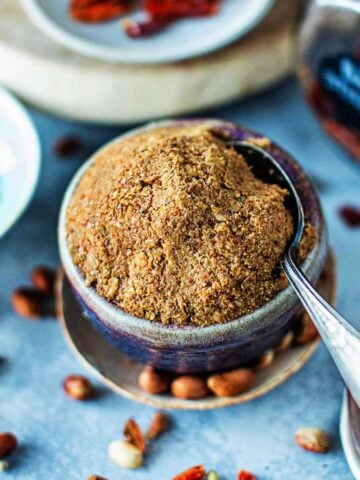
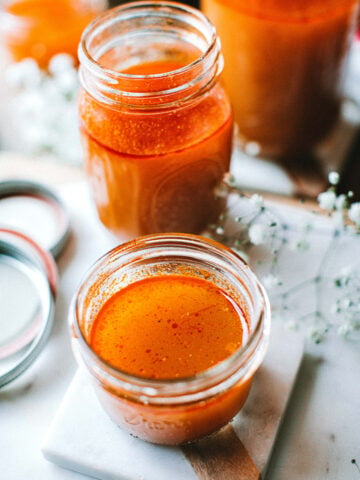
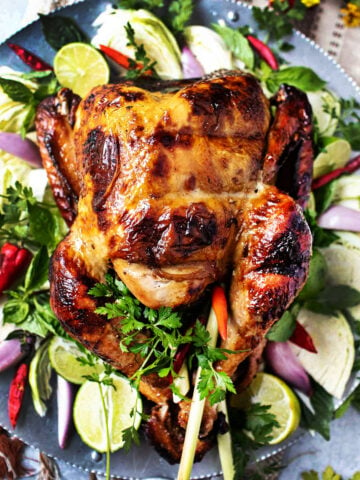
Suwanee
Oh wow! Thank you so much, Adriana,
Love hearing how well this turned out for you! I'm so delighted!
Suwanee
Adriana
Rich, decadent, must make recipe! Flavors are quite deeper, sharper, and brighter than when using the canned green curry paste. Tho with Suwanee’s tip of adding sautéed garlic to store bought curry paste it makes a world of difference! And a wonderful quick meal if can’t make this recipe. I hope you try. It’s really delicious and I also didn’t have every ingredient and still came great!!!!
★★★★★
Suwanee
It's easier than it seems right? So happy to hear this!
Suwanee
Thank you!
Lizie
This Thai green curry is excellent! Thank you Suwanee!
★★★★★
Cassie
Making my own paste definitely stretched my abilities, but the payoff was worth it. It completely elevated the curry dish! Thank you!
★★★★★